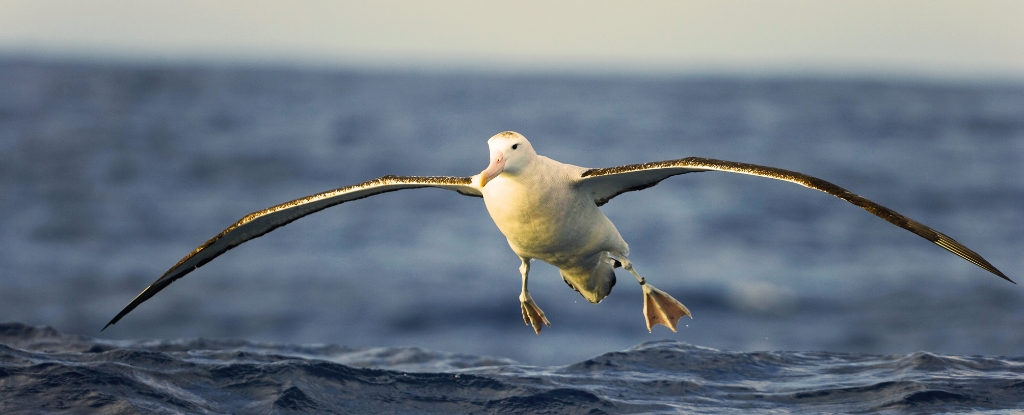
Creatures traverse remarkable distances in search of sustenance. While caribou, reindeer, and wolves achieve impressive mileage on terra firma, seabirds stand unmatched in their journeying extents.
Arctic terns embark on an incredible journey, voyaging from the Arctic to Antarctica and back in their annual migration. Wandering albatrosses (Diomedea exulans) cover a distance equivalent to traveling to the Moon and back ten times throughout their lifetimes.
Extensive studies have delved into the decision-making processes of seabirds when selecting flight routes and locating food sources. These avian navigators appear to rely on their vision or sense of smell to evaluate local conditions.
Wandering albatrosses are capable of covering over 10,000km during a solitary foraging journey, yet our understanding of how these birds utilize cues from their surroundings for mid- and long-range navigation remains limited. Learn more about their fascinating behavior here.
In a groundbreaking development, our recent study, detailed in this article, sheds light on how birds, including wandering albatrosses, may utilize sound to gauge conditions at a distance for the first time.
How seabirds use low-frequency sound
Earlier studies have indicated that seabirds are not just in search of information on where to locate food, but also on how to do so with optimal efficiency. Our findings reveal that the utilization of their auditory senses by wandering albatrosses may play a crucial role in this process.
Examining the behavior of these birds, our research focused on their reactions to infrasound, a low-frequency sound type capable of spanning thousands of kilometers.
While typically beyond the range of human hearing, we are aware that certain animals can perceive infrasound. When waves collide or crash against coastlines, they generate a type of infrasound known as microbarums. Our study specifically investigated this category of infrasound.
We understand that regions with intense wave activity may be linked to upwellings—where fish rise to the surface. Infrasound could serve as a valuable indicator of these areas, offering birds insights into fruitful foraging grounds.
Efficient foraging holds particular significance for larger seabird species like the wandering albatross, boasting an impressive wingspan of 3.5 meters. Due to their size, these birds depend on wind for efficient takeoff and flight, unlike smaller counterparts such as puffins, which flap their wings up to 400 times per minute.
Intense wave activity is indicative of robust winds. Considering our understanding that wandering albatrosses rely on wind for efficient flight, the findings from our team’s study propose that infrasound might serve as a long-range indicator for identifying optimal foraging conditions.
Infrasound is also produced during the impact of waves against coastlines, and it’s established that numerous coastal seabirds utilize the coast for plotting their flight trajectories and navigating back to their breeding colonies. Therefore, infrasound has the potential to disclose the presence of fixed features like coastlines, and furnishing seabirds with crucial information over extensive distances.
Despite the potential significance of this cue for seabirds, our paper, featured in PNAS, stands as the inaugural evidence that seabirds might exhibit responses to infrasound. This phenomenon is monitored globally via a network of sensors established by the Comprehensive Nuclear-Test-Ban Treaty Organization (CTBTO).
Originally designed to identify nuclear tests, the system produces extensive data that scientists can leverage. We integrated the CTBTO’s data with our own GPS tracking information from 89 wandering albatrosses to analyze the correlation between microbarums and the birds’ movements.
What we learned?
This enabled us to extract data that revealed the decision-making process of these albatrosses in determining their next destination. Our results indicated that they opted for the direction with the most pronounced infrasound.
This implies that the birds might utilize infrasound to locate food or optimize energy expenditure during their journeys. However, the precise reason why louder areas are favored remains uncertain.
Our discoveries could also provide researchers with valuable insights into the decision-making processes of other birds during medium- and long-distance journeys.
Similar to many inaugural studies testing a hypothesis, our research prompts as many questions as it provides answers. If seabirds indeed respond to infrasound, they must possess the ability to hear it and discern its origin. While lab studies have presented evidence that certain birds can detect infrasound, there haven’t been specific tests conducted on seabirds.
Bringing a wandering albatross into a lab and establishing a sufficiently large sound chamber for experimental tests appears improbable in the short term. However, other seabird species can thrive in captivity, offering a potential focus for further research in this direction.
The documented impacts of climate change-induced weather fluctuations, as discussed in this article, are adversely affecting seabirds and various other flora and fauna. These changes make it more challenging for them to locate essential resources, such as food.
As human activities modify ocean habitats, the potential role of infrasound in assisting birds to adapt by locating food becomes crucial, especially in the face of diminishing stocks. Conversely, increased human-induced noise could potentially obscure this vital information, posing detrimental consequences for wildlife.
Regardless, comprehending the how and why behind seabirds’ utilization of infrasound is essential for scientists to grasp its significance in the context of the climate crisis.
This post has been reprinted from The Conversation under a Creative Commons license.





